LinkedIn is the best platform to cultivate a professional online identity. With over 60 million companies on the forum, it's an excellent opportunity to network, show authority in your field, and endorse the people you’ve worked with.
On LinkedIn, recommendations are like online reviews. They offer social proof of an individual’s competence, credibility, and expertise in their field. They appear on the bottom part of a profile page. By giving LinkedIn recommendations, you help your recipients establish professionalism within their network and make them stand out to recruiters.
So giving LinkedIn recommendations when your peers, clients, and managers ask for it is a sign of goodwill for your working relationship. You also help them advance in their careers.
In this article, I’ll guide you on how to write a concise and impactful recommendation on LinkedIn when someone asks for it. I’ll also cover the best practices for requesting recommendations and how you can use them to elevate your profile.
Let’s learn the dos and don'ts of crafting compelling recommendations.
Quick Answer ー TL;DR (Too Long; Didn’t Read)
When writing a LinkedIn recommendation, follow these tips:
- Write a personalized introduction.
- Provide specific details about the person's strengths and qualities.
- Highlight specific skills, achievements, and contributions.
- Use concrete examples from specific projects to highlight what the person does best and why you’d recommend them to others.
What are LinkedIn Recommendations?
LinkedIn recommendations work two ways — they serve as testimonials provided by those who know you in person or recommendations to those you’ve worked with. As the one giving the recommendation, you acknowledge the recommendee’s skills, expertise, and professional qualities.
Here’s what a LinkedIn recommendation looks like:
Why Do LinkedIn Recommendations Matter?
LinkedIn recommendations are social proof of professional abilities. They make potential clients more confident in engaging with the one being recommended.
LinkedIn's algorithm also prioritizes profiles with more recommendations since it can contain industry keywords that improve your visibility in search results within the platform.
LinkedIn recommendations are also great conversation starters. They can be an opportunity to reconnect with former colleagues and clients.
LinkedIn recommendations matter because of the following:
- Endorsement of expertise: Recommendations are a way for colleagues, supervisors, and clients to vouch for proven skills and work ethic.
- Personal branding: Recommendations elevate personal brand by highlighting strengths and positive attributes.
- Job search and career advancement: They provide evidence of achievements and capabilities. When recruiters review a LinkedIn profile during a talent search, positive recommendations set that talent apart from other candidates.
- Variety of perspectives: Since recommendations come from colleagues, supervisors, clients, or business partners, it helps in creating a balanced image of professional abilities.
- Networking: Requesting and giving recommendations is a way to strengthen work relationships. Writing a recommendation can prompt others to do the same for you.
To further build a strong presence on LinkedIn, attract work opportunities, and generate leads for your side hustle, post niche-specific content regularly. You can use a scheduling tool like Sprout Social or Vista Social to plan a month’s content.
How to Choose the Right Person to Recommend on LinkedIn
Recommending someone on LinkedIn also reflects on your judgment and credibility.
To create authentic recommendations with the power to impact a person’s career, you need to select the right individuals to recommend carefully.
Here’s what to consider when choosing the person to recommend:
- Identify your colleagues, supervisors, or clients. Look for people with whom you’ve had direct professional experiences. If you’ve had firsthand experience with their skills, work ethic, and accomplishments, you can provide a factual recommendation.
- Consider whether or not you can help the recipient achieve their professional goals. If the person seeks to advance their career in a specific role, you should be aware of it and be able to speak about their abilities and achievements in that context.
- Ensure you have a genuine and authentic connection with the person you recommend. Only when you have a real professional relationship with the person can you write an impactful recommendation. If not, it's better to refrain from providing a recommendation.
How to Write an Impactful Recommendation on LinkedIn
To craft a compelling LinkedIn recommendation, you need to highlight specific accomplishments, skills, and professional qualities that the individual has in a genuine and detailed manner.
Let’s look at the elements of writing a compelling recommendation.
1. Personalized Introduction
Begin the recommendation with a personalized introduction that sets the tone for the endorsement.
Mention how you know the person in the professional context to establish your credibility as a recommender.
Elaborate on your relationship with the individual, whether they are a colleague, supervisor, or business partner, to help the reader understand the nature of your connection and why your opinion holds weight.
For example:
“I’ve been Jakes’s client for over a year, and we’ve worked on several campaigns together.”
2. Specific Details About the Person's Strengths and Qualities
Go into specific details about the person's strengths, qualities, and characteristics. Instead of generic statements like saying they are reliable and hardworking, offer concrete examples that showcase their abilities.
For example:
“Jake has demonstrated an exceptional work ethic. He made an effort to understand our business goals and target audience and helped translate these insights into highly effective digital marketing strategies.
His ability to create effective campaigns for different social channels was truly impressive.”
Here’s another LinkedIn recommendation sample for your inspiration:
3. Their Achievements and Contributions
Focus on the person's skills, achievements, and contributions that stand out. It could be their leadership abilities, problem-solving skills, or notable projects.
Be specific in painting a vivid picture of the person's capabilities and accomplishments.
For example:
“One of the key skills that stood out was Jakes's proficiency in data analysis. He doesn’t just rely on vanity metrics; instead, he leverages analytics to derive meaningful insights. His data-driven approach allowed us to make informed decisions, optimize our campaigns in real time, and increase our ROI.”
Here’s another example of how you can wholeheartedly recommend a professional you’ve worked with:
4. Concrete Examples to Illustrate Key Points
Support your statements with concrete examples. Describing specific situations or projects where the person excelled provides evidence of their competence and reinforces the recommendation.
Express confidence in the person's abilities and potential to have an optimistic closing to the tone of your recommendation.
For example:
“I would not hesitate to work with Jake again in the future. If you're seeking a digital marketer with strategic thinking skills, creativity, and an exceptional work ethic, Jake is the professional you need. His contributions were instrumental in the success of our digital marketing initiatives, and I am confident she'll bring the same level of excellence to any project he undertakes.”
Tips for Writing an Outstanding Recommendation (with Examples)
Writing LinkedIn recommendations reflects positively on your character and work ethic and also showcases that you value team effort and collaboration.
Your recommendation can significantly impact the person's professional image, so take the time to craft a thoughtful endorsement.
Here are some tips for writing a LinkedIn recommendation to help elevate the LinkedIn profile of the person you’re recommending:
1. Be Genuine and Sincere
Write recommendations that are genuine and relatable. Provide specific examples of the person’s soft skills and accomplishments.
For example, Dustin’s recommendation on my LinkedIn profile is a good example of an impactful recommendation.
He starts by explaining the context of our professional interactions and why he is qualified to speak about my skills and character. He highlights the strengths and qualities that make me stand out as a digital marketing professional.
2. Highlight Specific Project-Related Achievements
Describe specific projects, achievements, or instances where the person's contributions created a positive impact on the project's outcome.
The above LinkedIn recommendation sample on Poya Osgouei’s profile backs up the endorsement with specific figures of what the recipient has achieved as a team member.
Backing up your statements with concrete examples and results makes your recommendation more impactful to the person’s career.
3. Be Concise
Keep the recommendation concise and focused. Aim for a balance between providing enough information to be meaningful and ensuring it's easily readable.
The sample above demonstrates how you can be very concise and still give a rich endorsement. Jay has mentioned their professional relationship and highlighted Lalaina’s skills and achievements concisely and straightforwardly.
4. Proofread Your Recommendation for Typos
Before you submit your recommendation, check for spelling mistakes or grammatical errors and fix them to ensure clarity and correctness.
A well-written recommendation should be error-free since it’s a reflection on you and the person you’re recommending.
Troubleshooting Common Challenges When Crafting LinkedIn Recommendations
Writing recommendations can pose several challenges too. For instance, you want to keep the recommendation concise and still provide specific examples of the person's strengths.
Here are common challenges of writing a recommendation and how you can overcome them:
1. Overcoming Writer's Block When Crafting Recommendations
Writer's block can impede your creativity process, making it challenging to articulate praise effectively.
To overcome it, start with bullet points or jot down key phrases to create an outline before crafting whole sentences. From there, you can come up with words to make your sentences flow smoothly.
2. Dealing with Requests for Recommendations When You Have Reservations
There may be instances where you have reservations about the person's abilities or work, but they still asked for a recommendation.
If you're uncomfortable providing a glowing endorsement, express your willingness to give a brief, neutral recommendation without going into extensive detail.
3. Navigating the Delicate Balance Between Honesty and Positivity
Balancing honesty with positivity can be challenging, especially if you want to provide constructive feedback without sounding too critical.
Highlight positive aspects first and then, if necessary, diplomatically provide constructive criticism.
Use supportive language that is encouraging while still addressing areas for improvement.
Recommendations need to be positive and showcase the person's strengths. If you have serious reservations, communicate your feedback tactfully or consider whether you're the right person to provide the recommendation.
In some cases, declining the request might be more appropriate if you cannot genuinely endorse the individual.
How to Request Recommendations From Your Peers
If you’re acting from the other end of the spectrum and needing to ask for a recommendation, you may wonder how to request one from your colleagues, clients, or business partners. So, I’m penning down this step-by-step process for requesting a recommendation on LinkedIn from your account managers or clients you’ve worked closely with.
Here you go:
- Log in to your LinkedIn account.
- Find the profile of the person from whom you want to request a recommendation.
- On their profile, locate the “More” button. It is usually next to the “Message” button.
- From the dropdown menu, choose “Request a Recommendation.”
- LinkedIn will prompt you to choose your relationship with the person, for instance, colleague, supervisor, or classmate. From the drop-down menu, select the option that best describes your connection.
- Select the position for which you want a recommendation from the list provided. This is normally a list of your job titles in the work experience section of your LinkedIn profile.
- Personalize your message and include details about why you're asking for the recommendation and any specific qualities or projects you'd like them to highlight. Remember to show your appreciation for their support.
- Click “Send” to submit your recommendation request.
The Best Practices for Requesting Recommendations on LinkedIn
A good LinkedIn recommendation elevates your profile and could impact your career aspirations positively. Therefore, you need to make some considerations as you send a request.
Here are the best practices for requesting a recommendation on LinkedIn:
- When sending a request, craft personalized messages. Do not copy and paste one message to all your peers.
- Mention specific projects or achievements you'd like them to highlight to make the process more focused.
- Request recommendations when your work with the person is still fresh in their mind so that they can provide detailed and relevant insights.
- Ask for recommendations from various colleagues who can speak about different aspects of your skills and character.
- Suggest key areas or skills you'd like the recommendation to focus on, but avoid providing a script. Allow your peers to share their genuine experiences about working with you.
- Express that you value honest feedback and want the recommendation to genuinely reflect your strengths and contributions.
- As soon as you receive a recommendation, respond promptly with a thank-you message to acknowledge the effort your peer put into crafting the recommendation.
- Be specific when expressing your gratitude. For instance, you can mention aspects of the recommendation that you found especially valuable.
- If appropriate, offer to provide a recommendation in return.
Exchange Meaningful Recommendations on LinkedIn
LinkedIn recommendations are powerful testimonials that amplify your profile's credibility and influence. As you request and provide recommendations, remember to be authentic.
Build meaningful connections that can positively impact your professional growth. Write recommendations that improve your work relationships and also provide useful insights to potential employers.
By implementing the best practices I’ve shared in this guide, you can craft personalized recommendations for your team members and also request recommendations from your peers.
So, get started and build a robust professional presence on LinkedIn.
Don’t forget to check out these solid LinkedIn profiles and LinkedIn headline examples to further optimize your profile on the network.

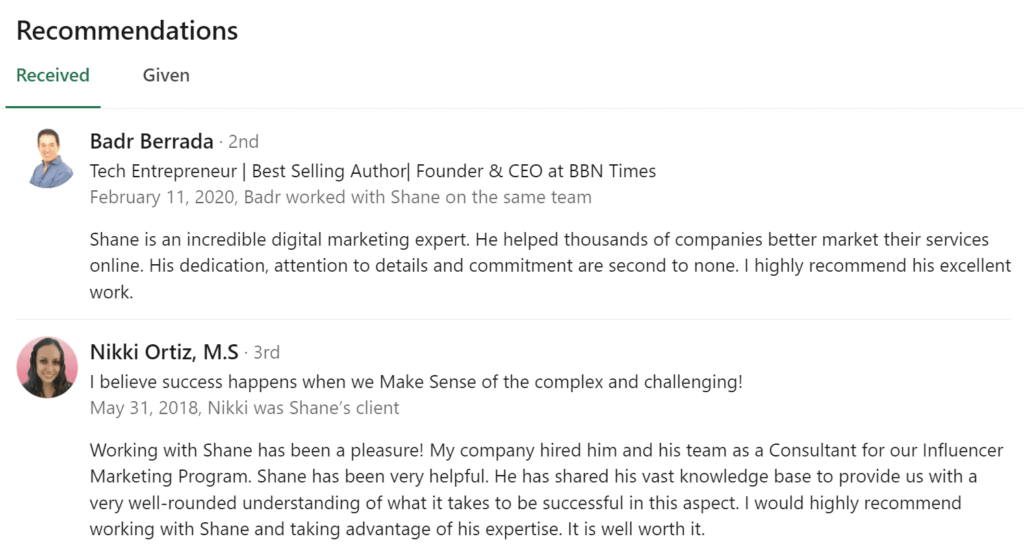
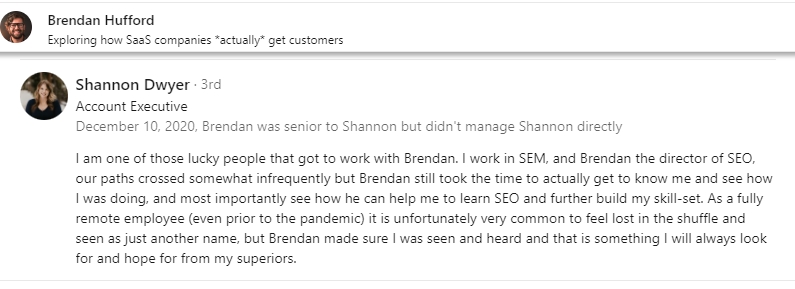

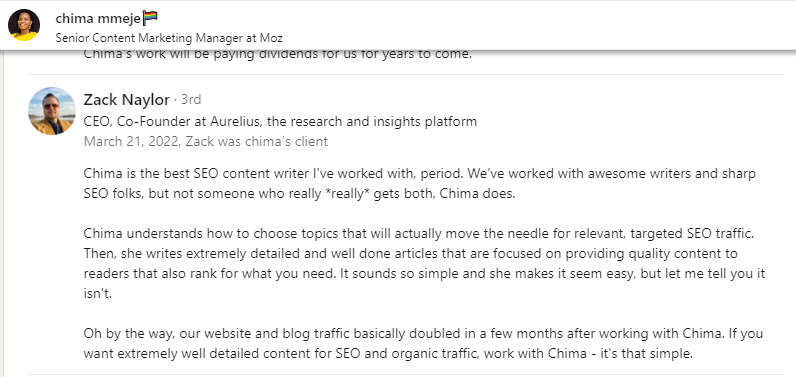
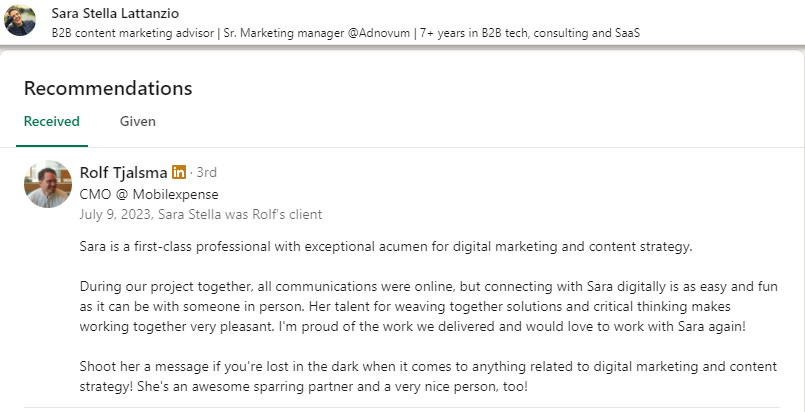
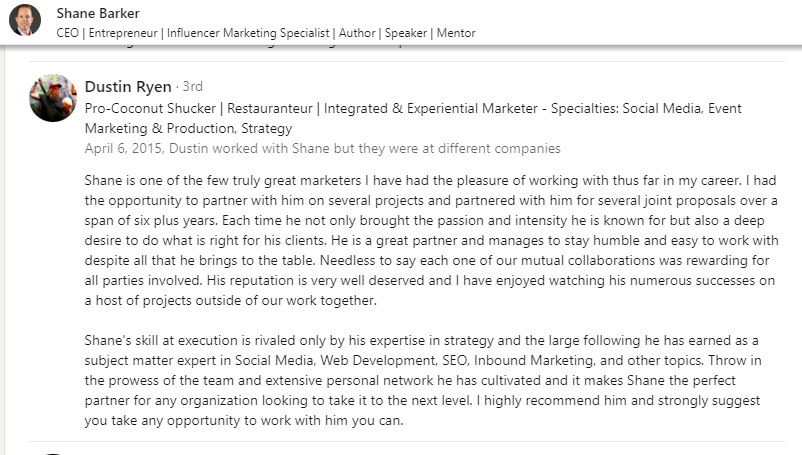


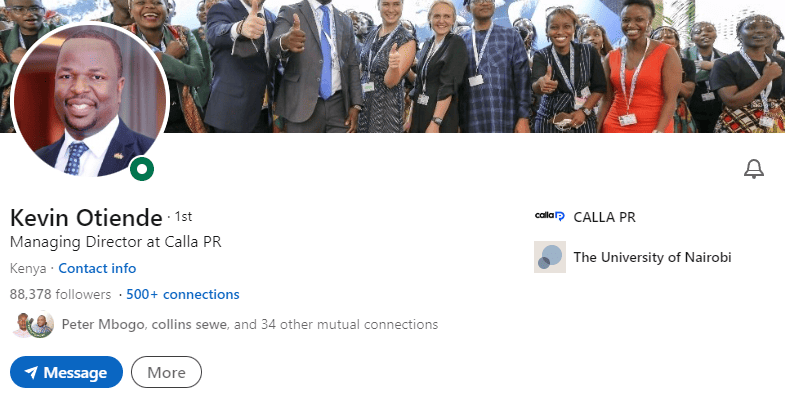
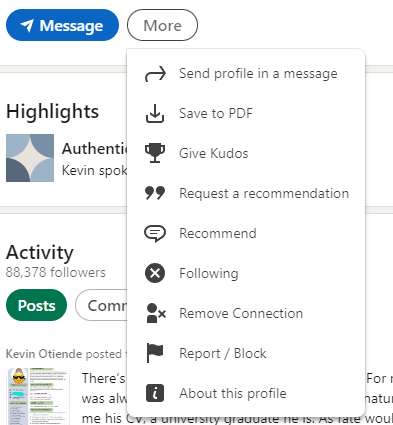
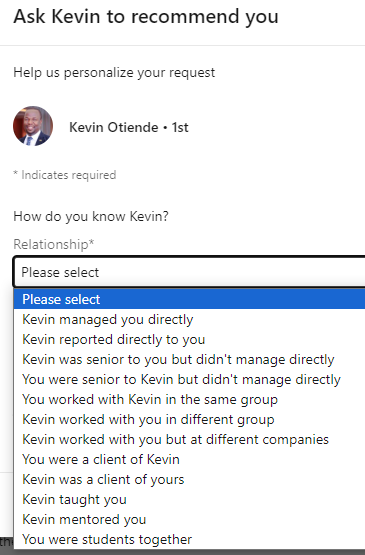

Related Articles
The Right Time to Post on Social Media: A Reliable Guide
7 Best B2C Marketing Channels for Social Media in 2024
How to Grow Social Media Organically: 19 Tools You Need To Use in 2024
30 Best Social Media Marketing Tools in 2024
7 Social Media Analytics Best Practices You Should Follow
19 Best Social Media Management Tools for Marketers in 2024